| 1 | The green anaconda’s smaller cousin |
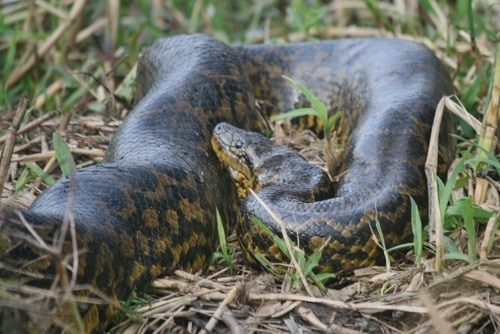
Everyone’s heard of the green anaconda, the Amazon river constrictor which is the 2nd longest snake in the world, which loves to ram humble fishing boats and even swallow small calves and regurgitate them. Less famous is its cousin the yellow anaconda, another member of the 4-strong anaconda (Eunectes) family.
Yellow anacondas are a similar, yet fully separate species. The first difference is their much yellower appearance, intermingled with black, and with youths having a sharper contrast. Secondly, they’re significantly shorter, while still being a hefty brute. Yellow anacondas average at 330-440cm, with a confirmed record of 4.6 metres, versus a confirmed record of 5.92 metres for green anacondas (6.27m is also rumoured). Reaching the river only to find a yellow anaconda coiled around your fishing boat wouldn’t be ideal, but they don’t quite join the top 10 longest snakes worldwide.
Finally, the yellow anaconda’s range is almost completely separate to its cousin. Green anacondas inhabit the Amazon rainforest basin proper, from Venezuela and Colombia in the north, through the heart of Brazil, with a southerly limit of northern Paraguay. Yellow anacondas live further to the south, in the Paraguay river and its tributaries. Their heartlands lie in southern Brazil (particularly Matto Grosso do Sol state) and western Paraguay, plus a large swathe of northern Argentina.
| 2 | Prowls rivers and marshland |
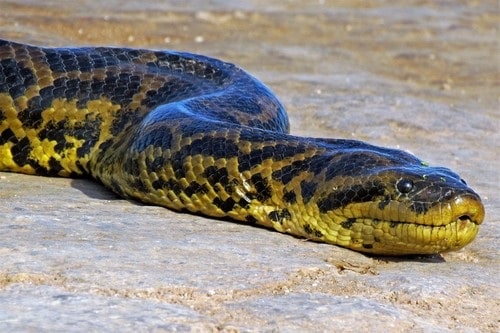
Yellow anacondas are a semi-aquatic snake, and their natural habitats include large marshes, slow-moving rivers, seasonally flooded grasslands, and murky swamps. They occupy not just rivers through forests, but flat, open marshes with virtually no tree cover. Yellow anacondas particularly love densely vegetated water, such as riverbanks, which grants them supreme disguise, swimming around like a submarine with most of their body underwater.
Yellow anacondas can be difficult to detect, except during winter (June to August), when they become more sedentary and rest on shores and riverbanks. This is a snake of many names: “curiyú” in Argentina and Paraguay, “sucuridjú” in Brazil and “sicurí amarilla” in Bolivia.
Male yellow anacondas have longer tails, but females are longer overall, and up to twice as thick. For example, after studying 1555 yellow anacondas in northern Argentina, the heaviest males and females weighed 10.5kg and 29kg respectively. The maximum lengths (excluding the tail) were 2.6 metres for males and 3.4 metres for females. There’s a simple way to distinguish between genders: large, spiky spurs on the males, which have an unknown purpose, and may be a useless evolutionary relic of legs.
| 3 | Still common in the wild |
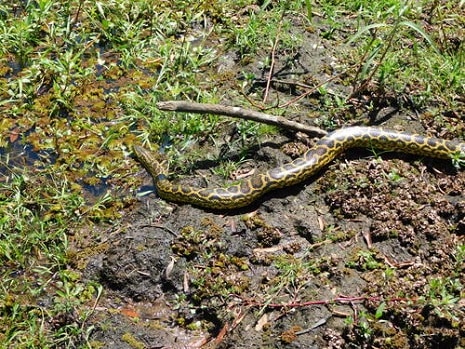
Yellow anacondas are far from rare. In their shallow wetlands, such as the Pantanal wetlands in far southern Brazil, they’ve been found to be the second most common snake after Brazilian smooth snakes, among 19 snake species observed. Together, the pair made up 34% of total snake sightings.
From third to fifth were the yellow-bellied liophis (Erythrolamprus poecilogyrus), coastal house snake (Mesotes strigatus), and leopard keelback (Helicops leopardinus). In 6th was Neuwied’s pitviper, and together, the top six made up 76% of all snake sightings. The rarest included Bothrops moojeni and the royal ground snake (Liophis reginae).
Yellow anacondas aren’t a rare beast which is only occasionally sighted in a blurry photograph like bigfoot – they’re everywhere. A study from northern Argentina found a population density of 30-60 per square kilometre. Extrapolated over their 400,000 km2 range, featuring the Paraguayan river and all its tributaries, this would create a yellow anaconda population of several million.
| 4 | Becomes hyper during wet season |
In October, the Argentine or Paraguayan wet season arrives, and yellow anacondas kick into a higher gear. Rivers burst their banks and spill into seasonally flooded wetlands, and yellow anacondas suddenly have the chance to disperse and conquer new rivers or swamps. From October to March, yellow anacondas are much more likely to be found away from their central river domains, such as in partially flooded farmland or villages. Strays have even reached Uruguay following floods, despite there being no permanent population.
Males are more adventurous, and are responsible for gene dispersal in the yellow anaconda species. While females can move distances of up to 2.5km annually, they stay within the same home range, rarely moving to new horizons. Pregnant females are particularly immobile, sometimes going 3 months without moving before giving birth
Eventually, dry season arrives and the party ends. Flood waters recede and yellow anacondas may become stranded. They might hang out in bushes, isolated ponds, or hollow palm trees, and one was found hiding in a hollow tree for a full month, with a small 5cm entrance they had wiggled through, waiting for the waters to return and allow safe passage. Yellow anacondas move much further during the wet season than dry season. While they can move on land, they’re relatively slow and halting, not at all fluent.
| 5 | Preys on storks and ducks |
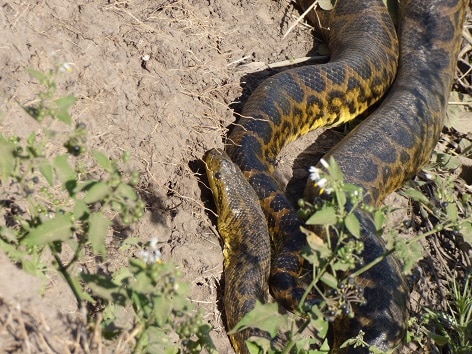
Yellow anacondas can survive for months without prey if need be, but according to a 2017 study, they eat relatively frequently if possible. Among yellow anacondas studied in La Estrella Marsh, Formosa province, northern Argentina, 68% had meals in their bellies. This study also provided the most detailed diet breakdown so far for yellow anacondas. It consisted of 65 yellow anacondas brought to the scientists by hunters, who they offered a financial reward, and a further 112 from older scientific databases.
The general reputation is that anacondas will guzzle up anything, and that’s partly true. But as you’d expect, they prefer semi-aquatic creatures, and this study revealed one especially common food group: wading birds. Females were found to eat 25 different bird species, and the largest included Maguari storks, Muskovy ducks and neotropic cormorants. They also ate some mammals, including guinea pigs and vesper mice. At 22.8% of prey for females, the marsh rat (Holochilus chacarius) was the most common prey, though only 5 actual mammal species were identified. The largest single prey was a mammal, a capybara. Two snakes were found in the females’ diets: the Brazilian smooth snake and another yellow anaconda.
Males ate fewer birds, due to their smaller size compared to females. However, 9 species were still recorded, most commonly the Monk parakeet. The most frequent prey for males was “unidentified rodent” at 30.8%, while marsh rats ranked in second at 25.6%.
| 6 | Lunges from shallow water |
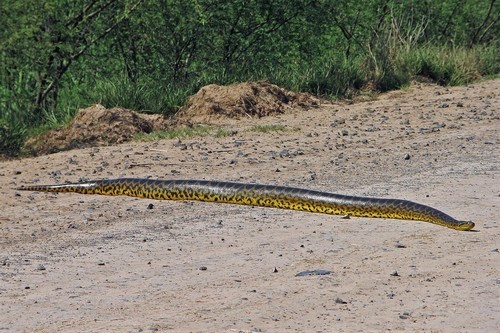
Many snakes eat birds as a chunk of their diet, but species that rely heavily on them are rare. Anacondas are the only snake genus on Earth that relies specifically on wading birds, as they’re the only group to combine monstrous size and a semi-aquatic inland habitat.
One of their rare weaknesses, meanwhile, is hunting fish. Most fish-eating snakes have a narrow head in order to reduce drag when striking at fast-moving fish underwater, but a yellow anaconda’s head is too bulky. Consequently, fish are rarely recorded in their diet.
Yellow anacondas use typical ambush tactics, lurking in shallow water covered with vegetation, and making sudden lunges at prey that pass. They rapidly apply coils, then constrict until their victim dies of asphyxiation. Another brutal tendency is pulling prey underwater during constriction, like a crocodile, although they don’t use a death roll that we know of (yet). Yellow anacondas have over 100 curved teeth which continuously regenerate, and are designed primarily for gripping prey.
| 7 | The exotic leather trade |
Though they live in untouched wetlands and rainforests, yellow anacondas cope decently with human disturbance. They appear in manmade irrigation canals, the metropolitan areas of Asunción (Paraguay), and even cope well with polluted waters. Rather than habitat obliteration, the greatest threat has long been human hunting. If you see a bag for sale with subtle boa patterns, it could be a fake textile lookalike, but it could also be a yellow anaconda skin, plucked from the Paraguay river and converted to luxury fashion in Milan.
The live yellow anaconda trade barely exists, with 477 exported in 30 years. It’s the skins which are popular, with 3500 harvested annually in Argentina, for export and conversion into handbags, wallets and exotic leather products. Most of these are from the northerly Formosa province, and for decades, this harvesting was an uncontrolled frenzy.
Between 1983 and 2002, an estimated 320,000 skins were exported from South America, mostly from Argentina and Paraguay. Another estimate was 296,748 skins exported from 1984 to 2013, mostly before 2002. This was actually an underestimate, as it didn’t incorporate yellow anaconda skins turned into belts, shoes, and bags prior to export. Italy was the largest importer, followed by Germany and the USA, with these countries accounting for 91% of the trade.
| 8 | The trade stabilises |
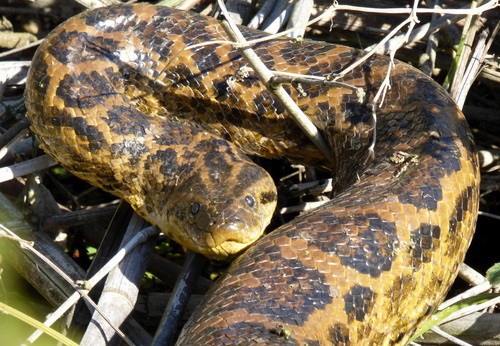
The yellow anaconda trade was never sophisticated at its peak. Traditional hunters prowled rivers and wetlands on foot, and whacked anacondas on the head with a blunt instrument like a pole when they found one. There were no high-tech traps or radars, and the anaconda was skinned immediately or at the hunter’s base, with the carcass tossed aside.
Hunting peaked during the cooler months of June to August, when yellow anacondas rested on the shores of rivers. The trade started in the 1930s, and reached an absolute peak in the 1940s. The Argentinean government attempted a ban in the 1950s, but illegal trading continued for decades. In 1986, a stricter ban was enforced on any trading, but by this time, hundreds of thousands of skins had been accumulated. After 10 years, the Argentinian government permitted existing stockpiles to be sold, meaning that 1996 was the hugest year for yellow anaconda skin exports ever, at nearly 70,000 exports.
By 2002, the existing stockpiles were depleted. The Argentine government then created the Yellow Anaconda Management Program (YAMP), designed to create a permanent sustainable industry. From 2002 to 2013, 55,660 yellow anaconda skins were exported internationally, with 88% originating from Argentina under their management program. These days, the species is in much stabler shape.
| 9 | Lays over 80 live young |
Yellow anacondas lay live young, but unlike many rattlesnakes, they abandon them instantly, leaving them to fend for themselves. Luckily, yellow anaconda neonates are far from helpless, and have fat reserves which allow them to go several weeks without hunting, before they get to grips with their innate anaconda hunting skills.
Yellow anacondas are solitary creatures, and never gather together in groups of 10-20 like a ridge-nosed rattlesnake. The only unions are between males and females.
Yellow anacondas grow for their entire lives. All juveniles have to do is reach adulthood, then they’re home and dry, as adults have no natural predators, except for humans wanting to turn them into handbags. As juveniles, they’re hunted by caimans, crab-eating foxes and tegu lizards. Dodge these for 3 years, and they’ll be too large for all but the cockiest jungle creatures to take on.
Average clutch sizes vary from 4 to an enormous 82. It’s possible that yellow anacondas break 100 young per batch occasionally, away from prying human eyes. Generally, semi-aquatic snakes lay the highest number of offspring, as a defence against a plethora of watery predators – see checkered keelbacks and mud snakes.
| 10 | Not an easy captive pet |
Yellow anacondas have a reputation for aggression in captivity, to the point of being a “total nightmare” or “evil”, and pet shops being desperate to get rid of them, flogging them off for bargain basement prices just to end the torment. Though they lack venom, yellow anacondas can inflict agonising bites on inexperienced keepers. Many snakes begin life as nippy and calm down with age, but yellow anacondas may never calm down. Others have been described as gentle, so there seems to be a wide spectrum of personalities.
Yellow anacondas are also feared to be invasive in the Florida everglades, which would be a virtual paradise for them, an endless vista of untouched marshes. Though far less widespread than the Burmese python, imports of Eunectes notaeus have been banned in the USA since 2012, to prevent a complete takeover.
One yellow anaconda study followed 8 individuals over 6-8 months. It found a mean monthly movement of 188 meters, but with large variation: one female moved 474.8 metres monthly, while a male moved 30.1 metres and another female moved just 30.4 per average month. Across the 8 individuals, the average water depths varied from 0.4 to 2.0 metres, relatively shallow. The anacondas were found on old abandoned farmland more commonly than expected, and particularly favoured tributaries rather than the wide centres of rivers.
